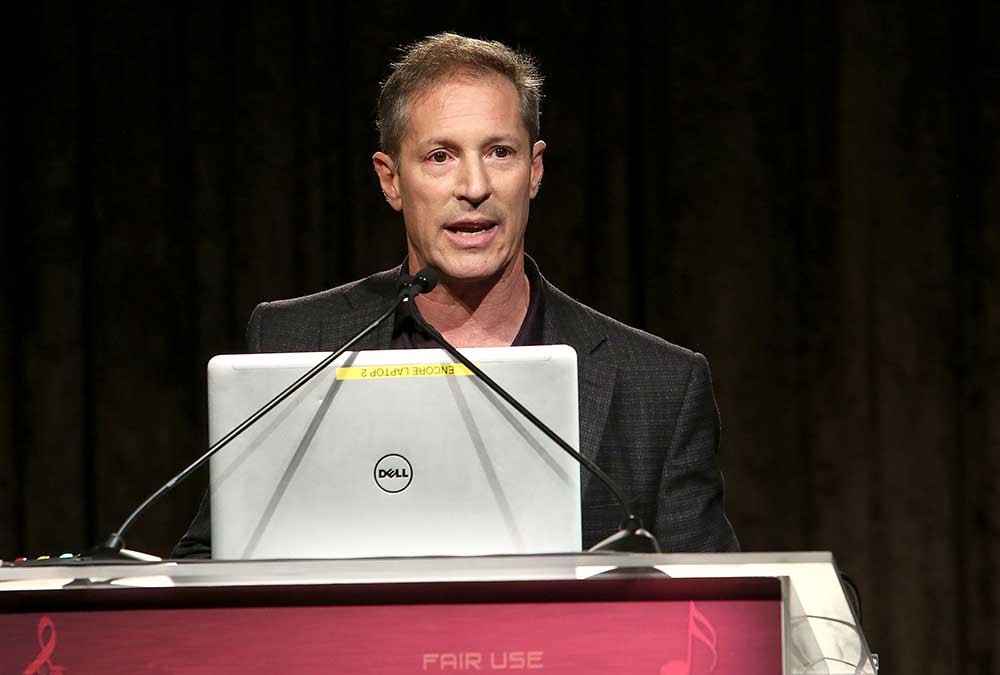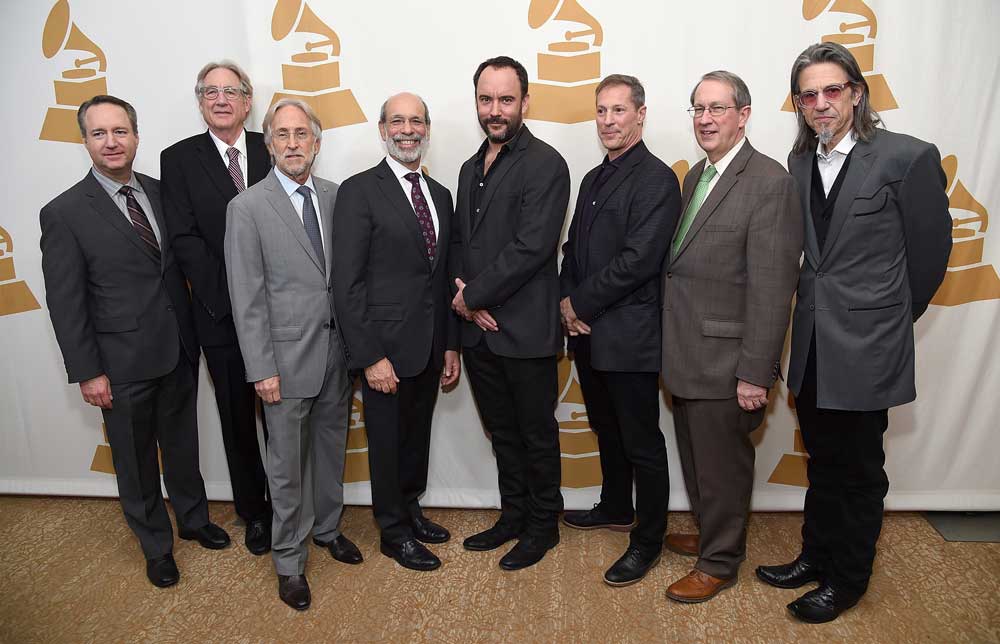
William Morris Endeavor head of music Marc Geiger conjured a tale of economic drama, playing out on the battlefield of art and commerce. (Photo: Jesse Grant/WireImage)
WME head of music Marc Geiger engaged music attorneys — and artist Dave Matthews — over lunch with his five point presentation on the future of the record industry. The big takeaway: yes, the music biz has bounced back thanks to paid subscription services, but the current bump is small change compared to the riches ahead. “Publishers, labels and digital companies are soon to be flush with cash. Return of the private jet,” Geiger predicted at the conclusion to his keynote address at the Grammy Foundation’s Entertainment Law Initiative (ELI) luncheon.
This upbeat turn of events is due to what Geiger envisions as a bundled future, in which today’s popular individual music subscriptions will be replaced with aggregated entertainment services offered by Amazon, Google and other “giants.” Music, Geiger predicts, will be a fractional yet significant component.
A big challenge will be sorting out how much musicians and record labels can claim as their share in these lucrative transactions (apropos of the “value gap” debate that heated up last year). As the business models change, artists are more in need of solid advice, boding well for the lawyers in the audience of 450 (including entrepreneurs, managers and other professionals) at the Feb. 10, 2017, gathering at the Beverly Wilshire Hotel.
Thanks to technology, artists can self-publish, own their own copyrights and do all types of deals than they could before, a boon for this audience: “Revenue share deals are available from all kinds of partners. Independent artists and their funds are proliferating with different models. Clients are more in need of advice and legal expertise through this jungle than ever before.”
A Plague and 20 Years War
Anyone wondering how to make a PowerPoint enthralling can take note of Geiger’s presentation, which included thorough research and stills of epic battle (mainly from The Lord of the Rings). Geiger started out with a historical overview of a 20-years war that swept through the ’90s, bringing with it death through theft and royalty starvation. The war consumed “all the money, and all the property,” he said pausing a beat before adding, “except for live shows. That’s why we’re in the agency business,” prompting laughs.
More “plagues” in the form of digital rights management, large file sizes and slow bandwidth, took further toll, coupled with label and publisher wars (“lawsuits – good for you guys!”), consolidation, copyright infringement and general mayhem. Which brought him to the current chapter, “The Giants Save the Day,” wherein “order is restored, and the world shuts up and watches.” The giants are services like Apple Music, Amazon and Pandora, “the music equivalents of Godzilla, King Kong and Mothra.” Taking the field, they’re prepared to stomp all comers as they flaunt user bases in the hundreds of millions, internal payment systems and blended billing in a heroic clash of pricing and scale.
What happens next sets the big reveal for Geiger’s five predictions for the next five years.

The giants are coming! (Photo courtesy New Line Cinema)
1. The Big Get Bigger
“I don’t think Spotify goes it alone in the war — Netflix or somebody takes them out. Napster and Rhapsody, they’re going to sell, whether it’s to Verizon or somebody else. Tidal is going to finish its deal with Sprint. Amazon is going to launch and crush the voice activation. Google and YouTube remain conflicted – ad-driven, subscriber, this, that and the other…. they don’t get it right for a while. Pandora sells to Sirius and John Malone, even though that deal fell apart a minute ago. Shazam goes to… somebody. And Deezer and Saavn sell to QQ Music and 10 Cent. If you don’t know QQ Music, they’re number two in subscribers around the world.”
2. A Streaming Gusher
“Streaming numbers are going to get really, really, really big. I’m putting my you-know-what on the line and saying within X amount of years 500 million to a billion customers are going to pay for music as part of blended subscriptions. This prediction implies that the record, or recording and publishing businesses together will be well over a hundred billion dollars. My outside mark is $150-200 billion. That’s six, seven, eight times where we are today.” Ancillaries like live touring, merchandise and sponsorship will “grow commensurately as music consumption continues.” Geiger used the fact that he was to six Grammy events — “all of them packed and three shut down by the police” — as a sign that the music industry is “not only back but going into a robust period.”
3. Financial Rebuilding
Digital revenue is trackable. “It’s all on log files. There’s no more hidden money. But if you try to ingest an 800-page royalty report into an accounting system, that system does not yet exist,” Geiger said, noting the revenue streams are still only miniscule, in the tens of millions of customers, compared to where they’re going to be. What’s needed, he said, is “a re-piping of the financial systems,” including by the performing rights organizations. “These new systems, they’ve gotta be global, they’ve gotta be transparent, and they’ve gotta be real-time, and they’ve gotta be all royalty streams on one dashboard. That’ what as consumers, as industry leaders, we now expect from a world that gives us Amazon.” It took 5-10 years for the larger financial systems to get rebuilt, from tellers to ATMs, and the music industry is facing a like timeframe. “I promise you, this is huge. There are disruptors all around who are building for this new age. Kobalt is an example, and there are many others.” Geiger cited SESAC’s sale to Blackstone in January as a sign of the times.

Prepare for disruption. (Photo courtesy New Line Cinema)
4. New Subscription Era
“This is the big one! As a wanna-be engineer, years ago I saw how this system was gonna work, and I’m here to tell you what you think is a music subscription today is not what it’s going to be in three years. Independent music subscriptions are going to be old quickly. In the age of Google Play, Amazon Prime and soon Apple TV/music/media, bundled services will replace your cable bundle.” Geiger sketched out home bundles that couple phone, mobile, data and TV, envisioning a future in which music gets added to that mix and “the price of the pipe probably gets decoupled.” The content cost will be $99 and up, “and it’s going to be adopted en mass. The question for everyone in this room is, how much of the $99 goes towards the music? I have no idea. I don’t know if it’s usage based, I don’t know if it’s flat rate. This is going to be the biggest decision we have. Because if somebody pays 99 bucks and they watch some video and listen to a ton of music… This is going to happen. The biggest of the big are going for this hardcore. Amazon prime is already in there, and they throw in shipping.” Once consumers are in, it will be hard to switch. “The churn is going to be low, because it’s not just music, it’s multiple libraries, multiple preferences, multiple things built-in. It’s going to be music, video, films, photos, books, podcasts, YouTube and other OTT channels all blended.”
5. Superstar Draft
“Working in technology it’s been interesting to see the collision between northern California and southern California,” Geiger said, underscoring the classic clash between creative and tech. “Major entertainment executives have switched sides, and we’re slowly starting to see their impact, he said, rattling off Apple Music’s Jimmy Iovine and Zane Lowe and Take-Two Interactive CEO and former BMG chief Strauss Zelnick. “This was the first round, and there’s a lot of action yet to come.” Key to remember: “Nobody, and I mean nobody, likes to negotiate and increase rates, or increase payments to you or the creative community when they’re losing a hundred million dollars. Alright? This industry, in my opinion, needs to allow the numbers to get big enough to start reaping profits, just like we’re seeing profits at the labels today now that they’re back and can get some action off subscription.” When that turning point occurs, “everybody in this room is going to go for the throat. And then everybody in the room is going to negotiate the hell out of all these deals. Don’t do it early, and don’t do it before the players get in place and have sensitivities to everything that we in this room already know.”
‘We’re Worth It’
As all of this plays out, Geiger predicts more confusion and quicksand shifting beneath the industry’s feet. “Remember copycat behavior drives software development, and it drives deals as well. I watch when people follow Universal Music Group into deals when they’re setting rates. It’s gonna just keep happening we should all just accept it. It’s the natural order of technology development.”
Moving toward the all-streaming future (one exception he noted is books), Geiger stressed the need to hold firm on pricing. Things like new release tiering have barely begun. Meanwhile, the paradox of “all-you-can-eat for $10 a month and still everyone complains” has somewhat devalued creative currencies. “The industry needs to actually shore up and say, ‘No! We’re worth it!’ Because the artists are, you are, the labels are. For the last 15 years everybody had their back against the wall, and thought nobody would pay. No one understands blended offerings yet. If you’re Amazon Prime you don’t even understand it. The industry has no idea – this is true! – where the money is coming, going, nor do the creators. Some people want to keep it that way.”
The industry tracked more than a trillion streams in the first six months of 2016, and looks on track to double the pace in 2017. “So everybody calm down let’s get strategic. The next few years are going to be marked by rapid user growth, refinement of all these offerings, personalized interfaces, expanded libraries, confusion and complaining about the money, and lots and lots of inaction. But the new business is much, much, much bigger than the old. There’s more to sort out than ever before. The M&A and bundled services stuff alone is going to be a field day of negotiations for everybody.”

From left: Grammy Chief Advocacy Officer Daryl P. Friedman; attorney Henry W. Root; Recording Academy and Grammy Foundation President and CEO Neil Portnow; honoree and music attorney Elliot Groffman; musician Dave Matthews; keynote speaker and William Morris Endeavor head of music Marc Geiger; U.S. Congressman Bob Goodlatte; and the Grammy Foundation’s Scott Goldman, photographed at the Grammy Foundation’s Entertainment Law Initiative lunch. (Photo by Michael Kovac/WireImage)


Comments are closed.